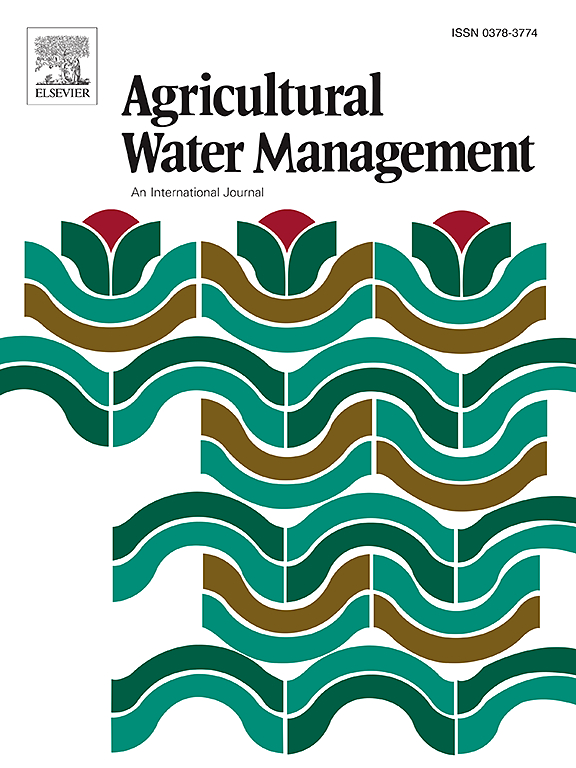利用Sentinel-1和ASCAT进行高分辨率干旱监测:以莫桑比克为例
IF 5.9
1区 农林科学
Q1 AGRONOMY
引用次数: 0
摘要
本研究探讨了主动微波遥感在莫桑比克开发基于地表土壤湿度(SSM)的高分辨率干旱指标的潜力。500米分辨率的SSM产品来自Sentinel-1 c波段雷达后向散射,使用变化检测模型(sssms1),并通过最先进的产品(包括ASCAT, ERA5-Land和SMAP)进行验证。结果表明,与现有数据集相比,SSMs1提供了更高空间分辨率的一致性湿度信息。从SSMs1中得到了两个干旱指标:土壤水分缺乏指数(SWDIs1),利用SSMs1和来自Soilgrids的辅助土壤特性,以及Z-scores1,结合ASCAT长期气气学和Sentinel-1空间分辨率开发了一个基于异常的指标。将SWDIs1和Z-scores1与莫桑比克6个地区的降水和植被异常进行了比较。降水异常表现出较低的区域变异性,通常不能反映旱季的干旱动态,但与雨季的地表土壤湿度(SSM)异常相关。与SWDI和Z-scores1相比,植被指标检测干旱的时间延迟,表明SSM在可观测到的植被异常之前提供了早期干旱发展的信息。研究结果突出了这些数据集的互补优势,并建议将它们结合起来用于早期预警系统。结合降水、植被和sssms1的信息,可以全面监测干旱的发展。这项研究有助于制定监测干旱的战略和改进早期预警系统,以提高小农的抵御能力,因为莫桑比克的社区往往依赖雨养农业。本文章由计算机程序翻译,如有差异,请以英文原文为准。

High-resolution drought monitoring with Sentinel-1 and ASCAT: A case-study over Mozambique
This study investigates the potential of active microwave remote sensing to develop high-resolution drought indicators based on surface soil moisture (SSM) in Mozambique. A 500-meter resolution SSM product is derived from Sentinel-1 C-band radar backscatter using a change detection model (SSMs1) and validated with state-of-the-art products including ASCAT, ERA5-Land, and SMAP. Results show that SSMs1 provides consistent moisture information with greater spatial resolution compared to existing datasets. Two drought indicators are derived from SSMs1: the soil water deficiency index (SWDIs1) using SSMs1 with auxiliary soil properties from Soilgrids, and the Z-scores1, combining ASCAT long-term climatology with Sentinel-1 spatial resolution to develop an anomaly-based indicator. Both SWDIs1 and Z-scores1 are compared against precipitation and vegetation anomalies in six regions of Mozambique. Precipitation anomalies show low regional variability and often fail to capture drought dynamics during the dry season, yet correlate with Surface Soil Moisture (SSM) anomalies during the rainy season. The vegetation indicator detects drought with a temporal delay compared to both SWDI and Z-scores1, suggesting that SSM provide information on earlier drought development, prior to observable vegetation anomalies. The results highlight the complementary strengths of these datasets and suggest their combined use in early warning systems. Combining information from precipitation, vegetation, and SSMs1 enables complete monitoring of drought development. This research contributes to the development of strategies to monitor droughts and the improvement of early warning systems to improve the resilience of smallholder farmers as communities in Mozambique often rely on rain-fed agriculture.
求助全文
通过发布文献求助,成功后即可免费获取论文全文。
去求助
来源期刊

Agricultural Water Management
农林科学-农艺学
CiteScore
12.10
自引率
14.90%
发文量
648
审稿时长
4.9 months
期刊介绍:
Agricultural Water Management publishes papers of international significance relating to the science, economics, and policy of agricultural water management. In all cases, manuscripts must address implications and provide insight regarding agricultural water management.
 求助内容:
求助内容: 应助结果提醒方式:
应助结果提醒方式:


